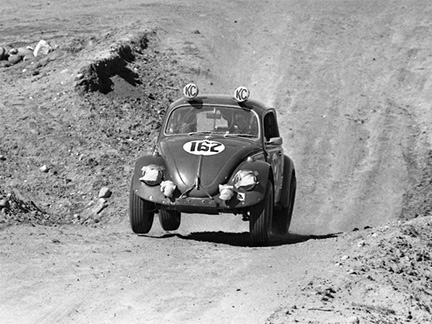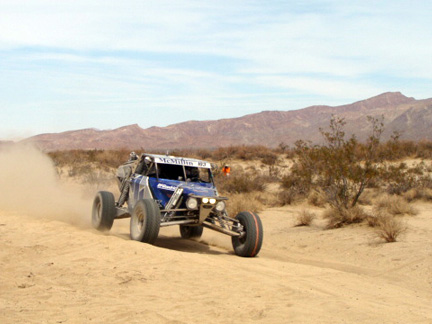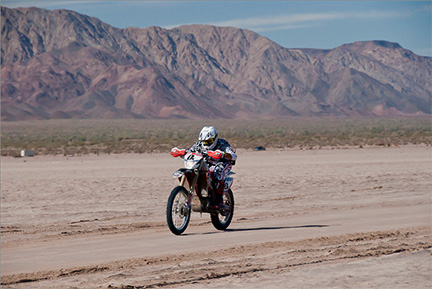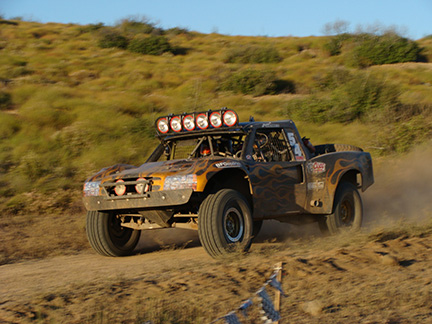 |  |
by Steve Kassanyi and the Baja Bound staff
The roots of Baja racing likely trace back to the Ekins brothers of Los Angeles. In 1962, Bud Ekins, a Hollywood stuntman
and motorcycle racer was approached by American Honda for a suggested route to test the durability of their new CL72
Scrambler. Bud's idea was to do a timed 950 mile run from Tijuana to La Paz which was indeed going to be a serious
challenge for both the bike and rider. Bud's brother agreed to do the ride along with Bill Robertson Jr. who owned a
 Honda dealership in Hollywood. The solution for authentication was for the riders to send telegrams at the start in Tijuana
and the finish in La Paz.
Honda dealership in Hollywood. The solution for authentication was for the riders to send telegrams at the start in Tijuana
and the finish in La Paz.
From the very beginning a logistical nightmare presented itself, that of fuel availability. The last Pemex station was in Ensenada, with nothing else until La Paz. The riders compensated by strapping a one gallon plastic can inside a cargo bag mounted on top of the motorcycle’s fuel tank. The rest of the planned fuel stops came from an airplane chasing the guys, and landing every 80 miles where the plane’s fuel supply was lessened by filtering a few gallons of gas through a chamois one gallon at a time from the plane’s wing tanks. There were also ranchos along the way, where the owners could be persuaded to part with a few gallons of fuel from their 55 gallon drums at the ranch. Having the plane along on this adventure was also a bonus to the guys, as the plane was used to determine the better route down the peninsula. Back then, there were two options: the Gulf side which offered a more traveled “road”, or the Pacific side that was shorter and seemed to have fewer rocks, the bane of a motorcycle rider in Baja.

There were other problems encountered along the way, mostly caused by Mother Nature. Heavy fog was the primary offender. Also the plane would pre-position a few gallons of gas and cheese sandwiches at predetermined locations for the riders, when there wasn’t time to wait for them. Another problem developed from night time riding, the result being that the riders would get lost and ride around in circles, not realizing what they were doing. The best strategy was to wait for daylight to continue. Once the riders reached La Purisima, the road became hard-pack down to Ciudad Constitucion, and from there the last 130 miles to reach La Paz were on pothole studded pavement. The Ekins brothers with help from the Robertsons reached the La Paz telegraph office four minutes shy of forty hours to accomplish their mission. These telegrams still exist, in the archives of the June 1962 issue of Cycle World magazine.
This accomplishment inspired Ed Pearlman to create NORRA (National Off-Road Racing Association) and run the first Mexican
1000 race from Tijuana to La Paz in 1967. The race included motorcycles, cars and trucks competing on the same course in a
rally format with mandatory checkpoints along the way. The next six years saw the annual Mexican 1000 race start in Ensenada
 and once in Mexicali with the course running all the way to La Paz. NORRA also introduced the first Baja 500 in 1969.
and once in Mexicali with the course running all the way to La Paz. NORRA also introduced the first Baja 500 in 1969.
In 1973 the oil crisis hit and NORRA decided to opt out of the Mexican 1000 altogether and the organization was disbanded. However, the Baja government still wanted the race to go on as planned. A successful peninsula run was put on by the Baja Sports Committee that year, but they quickly discovered that putting on a race of this magnitude was much more difficult than they imagined. It was then the Baja Sports Committee enlisted the help of off-road racing promoter Mickey Thompson and his SCORE (Southern California Off-Road Enterprises) organization to help out. Although no races took place in 1974 because of the fuel crisis, Thompson hired Sal Fish of Hot Rod Magazine who eventually took over the new SCORE International and grew it into the preeminent Baja racing organization known worldwide. In that time Sal also introduced the San Felipe 250, which ran for the first time in 1982 and has been a part of the SCORE racing series ever since. In 2012, Sal sold SCORE International to businessman and avid off-road racer Roger Norman.

In addition to SCORE there are several other organizations that have emerged to promote racing in Baja such as CODE and RECORD, who specialize in promoting quality shorter desert racing events for all classes of vehicles between Ensenada, Mexicali, and San Felipe. NORRA was also reformed in 2009 by Ed Pearlman's son Mike, and the Mexican 1000 multi-day rally format has come back strong with everything from nostalgic vintage vehicles that raced the first Mexican 1000 to modern day trophy trucks. The sport of Baja racing has developed to the point where one can find events taking place every month somewhere on the peninsula. These races are always welcomed by the Baja community, as locals come out by the thousands to spectate and get a photo or autograph from their favorite racers.
As these racing events have evolved through the years, so have the types of vehicles and classes that participate. While the initial Mexican 1000 only had a handful of vehicle types, a modern day SCORE race will host close to 40 classes based upon vehicle type, skill level and age. The vehicles range from the relatively inexpensive motorcycles and quads all the way up to the unlimited trophy truck and class 1 vehicles that cost hundreds of thousands of dollars to build. In between there are classes for buggies, Jeeps, UTV's and Baja Bugs and many more.

The sport has created its own legends over the years such as Parnelli Jones, Rod Hall, Walker Evans, Johnny Campbell, the McMillin family, Malcolm Smith, J.N. Roberts, Bill Stroppe, Larry Roeseler, the father/son effort of Bob Gordon and Robby Gordon and Ivan “Ironman” Stewart. Of note, Rod Hall is the only person who has competed in every Baja 1000 since 1967 and has 21 Baja 1000 class wins and 18 Baja 500 wins. Johnny Campbell has won an amazing 11 overall Baja 1000 titles the Honda motorcycle team. Behind all these names are also the mechanics, chase crews and support staff that prepare months in advance for race day and do everything they can to get their team across the finish line. While many of the professional teams can provide their own support crews, the smaller "privateer" teams often rely upon pit support organizations such as Checkers Off-Road, F.A.I.R, JCR Pits, Baja Pits and MAG-7. These organizations rely heavily upon volunteers to staff their pits, but the payoff is a front row seat to all of the great racing action, and an opportunity to contribute to the success of the racers you are supporting.

It is safe to say that the sport of off-road racing is alive and well in Baja with almost 50 years of colorful history. As long as the local governments and land owners are willing to host these Baja racing adventures, we will hopefully have many years more to come.
Photos: Trackside Photo, Morgan Hill, Donal Hill